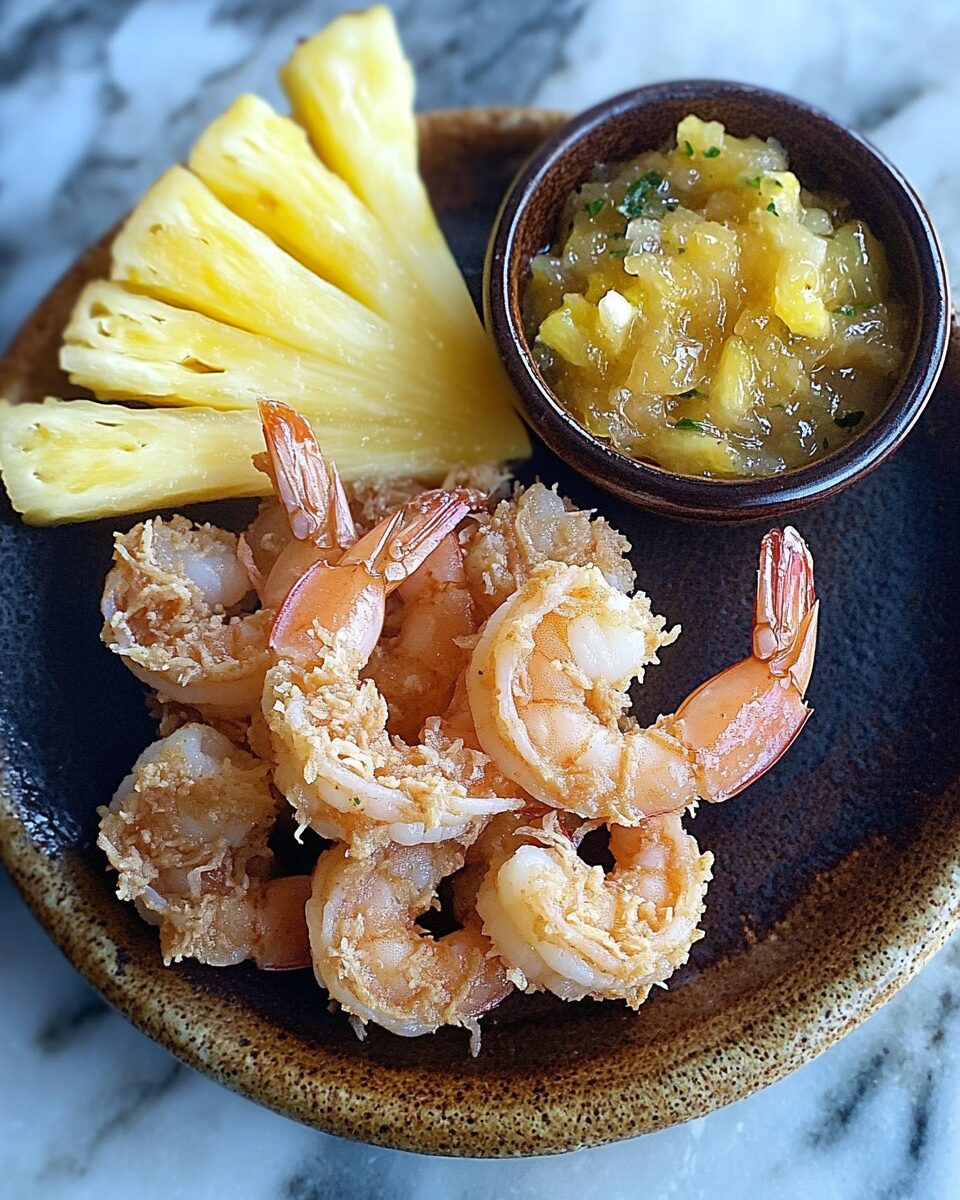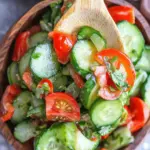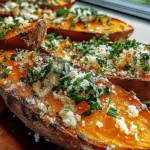This crispy coconut shrimp is golden, crunchy, and slightly sweet, complemented by a punchy pineapple-habanero salsa that’s both tropical and spicy. The pairing creates a perfect balance—sweetness from the coconut and pineapple, heat from the habanero, and zest from fresh citrus notes. It’s a dish that transports you straight to a beachside cabana in Mexico. Whether served as an appetizer or a main course, it’s crowd-pleasing and surprisingly simple to prepare. The salsa can be made in advance and even improves in flavor the next day. So grab a cold drink, kick off your sandals, and dig in!
Full recipe:
Ingredients:
For the Pineapple-Habanero Salsa:
-
1/2 (800g / 1 3/4 pounds) fresh pineapple, peeled, cored, and cut into 1” pieces (about 1 pound peeled and cut)
-
1/4 small onion (40g / 1 1/2 ounces)
-
1 chile habanero, stemmed and seeded
-
1 large garlic clove, peeled and lightly crushed
-
1 tsp finely grated orange zest
-
2 to 4 tbsp freshly squeezed orange juice
-
Kosher salt, to taste
For the Coconut Shrimp:
-
1 pound (453g) large shrimp, peeled and deveined
-
1 tsp kosher salt
-
3/4 tsp freshly ground black pepper
-
1/2 tsp freshly ground allspice
-
2 large eggs, beaten with 1 tbsp water
-
3 cups shredded dried coconut, preferably sweetened, divided
-
1 cup (125g / 4.5 oz) all-purpose flour
-
4 cups virgin coconut oil or vegetable oil, for frying
Directions:
-
Make the Salsa:
Blend pineapple, onion, habanero, and garlic in a blender until nearly smooth. Transfer to a saucepan and bring to a boil over medium heat. Cook, stirring occasionally, until reduced by half and very thick (45 to 65 minutes). Remove from heat, stir in orange zest and juice. Season with salt. Adjust sweetness and consistency with more juice if needed. Set aside. -
Prep the Shrimp:
Toss shrimp with salt, pepper, and allspice in a bowl. Set up a dredging station with coconut (divided), flour, and egg wash. -
Bread the Shrimp:
Dredge shrimp in flour, coat in egg wash, and press into coconut to cover completely. Use half the coconut for the first batch, discard and use fresh coconut for the second half of shrimp. -
Fry the Shrimp:
Heat oil in a pot to 325°F. Fry shrimp in batches until golden, 1 to 2 minutes per batch. Transfer to a paper towel-lined sheet pan. -
Serve:
Serve shrimp warm with pineapple-habanero salsa on the side.
Prep Time: 25 minutes | Cooking Time: 1 hour 25 minutes | Total Time: 1 hour 50 minutes
Kcal: Approx. 480 kcal per serving | Servings: 4
The Story Behind Coconut Shrimp with Pineapple-Habanero Salsa
Coconut shrimp, also known as camarones al coco, is a beloved dish across tropical and coastal regions, especially in Mexico and the Caribbean. Its popularity stems from the beautiful contrast between sweet and savory, crunchy and tender, and mild and spicy. In this particular recipe by Rick Martinez, the traditional coconut shrimp is elevated with a slow-cooked pineapple-habanero salsa—a bold, tropical twist inspired by beachside eateries in Mazatlán, Mexico.
This isn’t just any coconut shrimp. It’s carefully designed to combine maximum crunch with layered flavors that hit your palate in waves—starting with the crispy coconut coating, then the juicy tenderness of the shrimp, and finally, the bold tang of the sweet-and-spicy salsa. It’s a dish that instantly transports you to sandy beaches and ocean breezes.
Rick, known for his contributions to Bon Appétit, the New York Times, and the Food Network, spent time living in Mexico, where he drew inspiration directly from local cuisines. His experience and respect for authentic flavors shine through every element of this dish.
Why This Recipe Stands Out
Many coconut shrimp recipes are enjoyable, but they often rely on shortcuts—pre-made batters, jarred sauces, or oven-baked textures that don’t quite satisfy. What makes this recipe stand apart is its thoughtful attention to flavor layering and texture.
- Sweetened shredded coconut adds a rich caramelization during frying that enhances the sweetness and crispiness of the shrimp.
- The use of allspice in the seasoning gives an earthy warmth that complements both the shrimp and the sweetness of the coconut.
- The pineapple-habanero salsa isn’t a quick mix of ingredients—it’s a slow-cooked, thick reduction that builds deep flavor over time.
- Orange zest and juice add complexity and freshness, balancing the heat from the habanero.
Each bite is the result of intention and harmony—no ingredient is out of place or unnecessary.
Nutritional Benefits of the Key Ingredients
This dish not only pleases your palate but also offers a few nutritional perks:
- Shrimp is high in lean protein, low in calories, and packed with selenium, vitamin B12, and iodine. It’s a heart-healthy seafood that supports muscle growth and metabolism.
- Pineapple provides vitamin C, antioxidants, and digestive enzymes like bromelain, which can aid in digestion and reduce inflammation.
- Garlic and habanero have antimicrobial and metabolism-boosting properties. Habanero also contains capsaicin, which supports cardiovascular health and fat burning.
- Coconut provides a dose of dietary fiber and healthy fats (especially if you use coconut oil for frying).
While the recipe is indulgent in flavor and fried for texture, it still incorporates natural, nutrient-dense ingredients that make it a more mindful treat than many typical fried appetizers.
A Taste of the Tropics in Every Bite
This dish evokes a vacation vibe with its tropical flavor profile. The coconut and pineapple create a sweet baseline, while the habanero kicks in with just enough spice to elevate—but not overpower—the dish. The crunchy golden crust of the shrimp delivers a satisfying bite that contrasts beautifully with the velvety salsa.
It’s an ideal meal to impress guests, spice up a date night, or add flair to your weekly dinner rotation. It works as both an appetizer and a main course, and pairs wonderfully with sides like:
- Cilantro-lime rice
- Mango-avocado salad
- Grilled plantains
- Corn tortillas or tostadas
- A chilled tropical cocktail or sparkling water with lime
Pro Tips for Success
Cooking this dish to perfection is easier than you might think. Here are a few tips to ensure you get restaurant-quality results at home:
- Use large, peeled, and deveined shrimp to save time and keep presentation clean.
- Don’t skip the dredging steps. Properly flouring, dipping, and coating the shrimp ensures the coconut sticks and crisps perfectly during frying.
- If possible, use coconut oil to fry the shrimp. It intensifies the coconut flavor and enhances aroma.
- Control the oil temperature. Use a thermometer to keep it around 325°F (163°C) for consistent frying without burning the coconut.
- Make the salsa a day ahead for even better depth of flavor. The resting time allows it to mellow and blend beautifully.
Customizing the Recipe to Your Taste
One of the beauties of this dish is its flexibility. You can customize it to suit your dietary preferences or spice tolerance:
- Lower the heat: Swap the habanero for a milder chili like jalapeño or skip it entirely for a more family-friendly version.
- Make it gluten-free: Use gluten-free flour or cornstarch instead of all-purpose flour.
- Add more fruitiness: Include mango or papaya chunks in the salsa for an extra sweet, tropical layer.
- Boost protein variety: Try the same method with scallops or firm white fish like cod or tilapia.
- Go vegan: Replace shrimp with thick cauliflower florets or tofu cubes—same crunch, different protein.
Perfect for Any Occasion
Whether you’re hosting a backyard barbecue, cooking a romantic dinner, or just indulging in a flavorful night in, this recipe suits any occasion:
- Dinner parties: Serve on a large platter with salsa on the side and some tropical cocktails.
- Holiday appetizers: A festive twist on finger food that adds flair to any spread.
- Family dinners: A fun and interactive dish that even picky eaters will enjoy.
- Food photography & social media: The colors, texture, and plating possibilities make it incredibly Instagram-worthy.
Its unique look and crowd-pleasing taste also make it a great choice for food bloggers, YouTube cooking channels, or anyone looking to diversify their food content.
What Makes the Salsa So Special
Unlike store-bought fruit salsas that are overly sweet or watery, this pineapple-habanero version is thick, smoky, spicy, and rich. The key? Slow cooking and reducing the ingredients over nearly an hour.
This method not only intensifies the pineapple’s natural sugars but also deepens the flavor of the garlic and onion. Adding the zest and juice of an orange right at the end brings brightness that lifts the entire salsa. It’s a sophisticated, gourmet-quality sauce made from just a few fresh ingredients.
And it’s so versatile—use leftovers on:
- Grilled chicken or pork
- Tacos and burritos
- Sandwiches and wraps
- Cheese boards
- Rice bowls
Conclusion
Food is more than flavor—it’s culture, memory, and connection. With every bite of this coconut shrimp and pineapple salsa, you taste a story: the sun-drenched beaches of Mazatlán, the passion of a cook living his dream, and the playful balance of comfort and adventure.
It’s a recipe that reminds us that we don’t need a plane ticket to experience the world—we just need a plate, a few good ingredients, and the right recipe.






